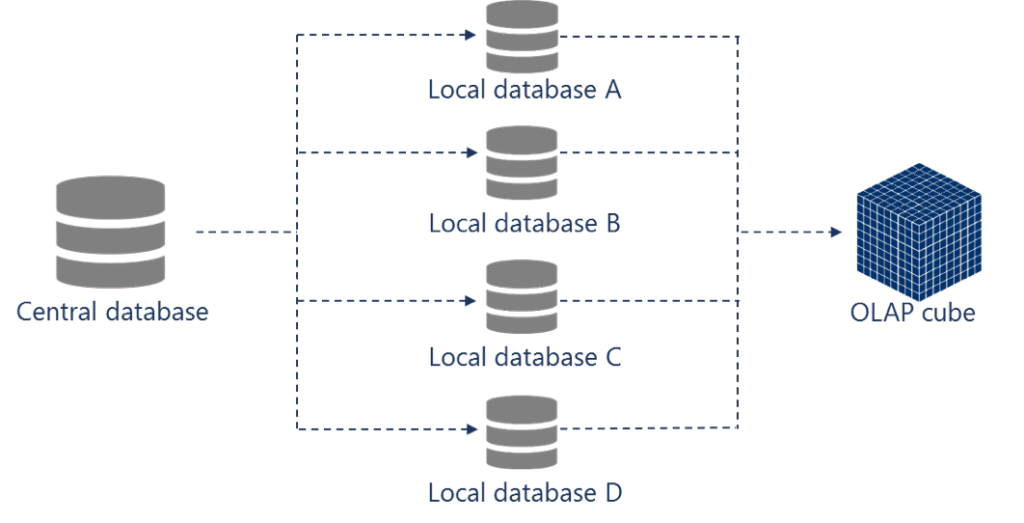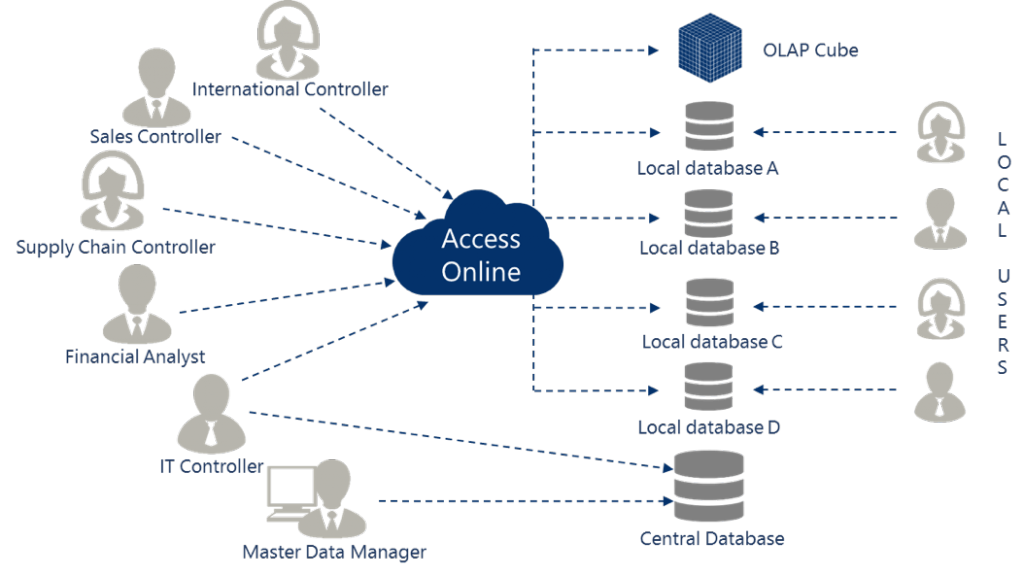
08 Jun Management report generated faster and month end closing process improvement – solution for international company
Implementation of one ERP system with standardized processes, settings and functionalities in all subsidiaries brings numerous benefits to international companies. The most noticeable advantages, in my opinion, are those related to finance and accounting, such asstandardized accounting processes and reporting in subsidiaries, faster management reports and month-end closing as well as improvement of internal audit.

Architecture of the standardized global ERP systems based on Microsoft Dynamics NAV (Navision)
Architecture of the group ERP systems streamlines global accounting processes
To achieve the above-mentioned benefits, it is necessary to implement one ERP system in all company subsidiaries. As IT.integro, the system we rely on is Microsoft Dynamics NAV. Let’s have a closer look at three basic elements of such global ERP systems architecture:
- central database – all master data is stored there,
- local databases – all databases are based on the Global Template for Microsoft Dynamics NAVwhich incorporates global assumptions for the entire group (e.g. process standardization) and their adjustment to the local requirements,
- OLAP cube – collects data from local databases, it is used for reporting and analysis.
Exchange of standardized dictionaries between companies
The consolidated global ERP systems assume also the introduction of centralized dictionaries related to: organizational structure, activity, cost dimensions, customers, components, products, vendors etc. Master Data Management System for Microsoft Dynamics NAV, developed by IT.integro, facilitates the exchange of dictionaries between company subsidiaries.
Standardization of accounting processes and management reports in international company
According to the presented architecture, the global platform based on Microsoft Dynamics NAV provides complete accounting setup, including centralized chart of accounts for the entire groupwhich must be compliant with international accounting standards such as IFRS and GAAP. Astandardized chart of accounts may contain only 3-5 ranges, in which local changes may be implemented (e.g. local costs, VAT accounts, cash registers and bank accounts). What’s more, the platform contains uniform dimensions for multiple subsidiaries. With Master Data Management System for Microsoft Dynamics NAV it is possible to block modifications in this area for subsidiaries as well as any other changes in accounting setup.
Improvement of month-end closing, management report generation and consolidation
With the global ERP platform based on Microsoft Dynamics NAV (Navision) it is possible to use one month-end closing process in all subsidiaries. If an accountant employed in a subsidiary receives an appropriate instructions document from the headquarters, he can easily and effortlessly close the month in compliance with standards adopted by the entire group. Such a document should contain a distribution list and a description of the month end closing process based on global master data. As a result, we can speed up the whole process not only at headquarters but also in subsidiaries. By following the established procedure during month closing on a regular basis, the only thing the locations will have to do is simply perform the assigned tasks. With consolidated ERP systems and a list of analytical reports, the process is performed automatically within Business Intelligence solution. As all subsidiaries work on one standardized ERP system, each report is provided in a format requested by the headquarters. The first step, however, is to specify management reports the month end closing process should apply to.
Streamline internal audit
Adopting the discussed approach will also help to streamline internal audits. Accounting setup is similar in all subsidiaries, which can significantly enhance work of the person responsible for conducting the audit. Without the before mentioned procedures, audits as well as group reporting become much more complicated. If multiple subsidiaries send their financial data in Excel worksheets, their checking and interpretation become a time-consuming and challenging task. The auditor working at the headquarters, unable to log into the local system and verify the correctness of data, must trust the data obtained from various company locations. As audits in respective locations are generally conducted by different controllers, standardization of accounting setup will not have the same effects as standardization of accounting setup in internal audits.
However, standardization of ERP systems does not affect the improvement of external audits.
By using one system in each business unit and ensuring a centralized access to databases, it is possible to log into any local database from the headquarters. A financial analyst is able to generate a report on a given subsidiary at any time. Preparing complex files by the subsidiaries is no longer necessary.

According to the presented architecture, a finance analyst at the headquarters has an access not only to OLAP cube but also to all local databases
One source of data for management report and consolidation
Multicurrency is an issue which may cause considerable difficulties in generating management reports and consolidation. Generally, management reports are prepared in the currency required by the headquarters while reports for consolidation purposes are prepared in local currencies. However, data consistency in this area is a must. By implementing Business Intelligence tool (e.g. Targit), which in my opinion will be the best solution in this case, all local charts of accounts can be kept in local currencies, which is compliant with legal requirements. With BI tool, the results may be consolidated and displayed in the currency selected by the headquarters.
Visit our website to find out more about financial consolidation.





